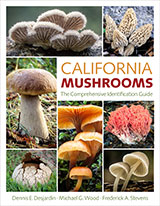The North American Species of Pholiota
27.Pholiota striatula sp. nov.
Illustrations: Text figs. 38-39; pl. 9b.
Pileus 1-3.5 cm latus, convexus, viscidus, hygrophanus, melleobrunneus, glaber, striatulatus. Lamellae adnatae, breve decurrentes, latae, subdistantes, brunneolae. Stipes 3-5 cm longus, 1.5-3 mm crassus, pallidus, submelleus, deorsum floccosus. Annulus evanescens. Sporae 8-10 x 4.5 -5.5 µ. Pleurocystidia nulla. Cheilocystidia 35-61 x 6-15 µ, subcapitate-filamentosa. Caulocystidia 20-65 x 6-16 µ. Specimen typicum in Herb. Univ. of Mich. conservatum est, legit prope Ophir, Colo. 17 Aug. 1956. Smith 52341.
Pileus 1-3.5 cm broad, convex, becoming expanded plane or margin slightly arched, viscid and hygrophanous, pale butterscotch color when young, darker butterscotch in age before fading to near pale pinkish buff, glabrous except for veil fragments over marginal area when young, striatulate when moist. Context moderately thick, but very soft and watery; odor none, taste mild.
Lamellae broadly adnate to short-decurrent, moderately broad to broad, subdistant, pallid-brownish becoming clay-color, edges minutely white-crenulate.
Stipe 3-5 cm long, 1.5-3 mm thick, pallid, tinged dilute honey color over all, with soft fibrillose patches up to the broken, evanscent annulus, base spongy but not darkening, equal or base slightly enlarged.
Spores 8-10 x 4.5-5.5 µ, smooth, apical pore extremely minute (under 1.4 N.A. lens); shape in face view broadly elliptic to subovate, in profile obscurely inequilateral to slightly bean-shaped; in KOH pale ochraceous tawny, in Melzer's reagent nearly the same color; wall about 0.3 µ (or slightly more) thick.
Basidia 24-28 x 5-6 µ, 2- and 4-spored, clavate, hyaline in Melzer's reagent. Pleurocystidia none. Cheilocystidia 35-61 x 6-15 µ filamentose-capitate to clavate or many with one or more enlargements beneath the apical enlargement, some spathulate at apex, walls thin smooth and hyaline, content homogeneous, but with small (1-3 µ diam.) thickenings of refractive material adhering to interior walls variously in some of the cells. Caulocystidia 20-65 x 6-15 µ versiform, (similar to cheilocystidia).
Gill trama of subparallel hyphae 6-17 µ broad, walls of cells thin hyaline and smooth; subhymenium indistinct, (cut ends of narrow hyaline non-gelatinous hyphae). Pileus cutis a thin gelatinous pellicle of narrow (3 µ ±) hyphae with smooth thin walls, loosely interwoven, hyaline in KOH; hypodermial region not differentiated. Context hyphae interwoven, hyaline, walls thin and smooth. Clamp connections present. All hyphae inamyloid.
Habit, Habitat, and Distribution: On soil and debris, under aspen, Colorado, August.
Observations: This agaric is distinguished by its colors, rather broad, subdistant, and white-crenulate lamellae. The cheilocystidia are large and conspicuous. The caulocystidia are in tufts and resemble the cheilocystidia. It might suggest P. pusilla, which has narrow gills which are at first white and has a white stipe with a ferruginous base, as well as smaller spores and cheilocystidia. It is closest to P. mutans from which the more poorly formed annulus, wider cheilocystidia and differently colored pileus distinguish it.
Material Examined: Colorado: Smith 52341 (type from Ophir).

